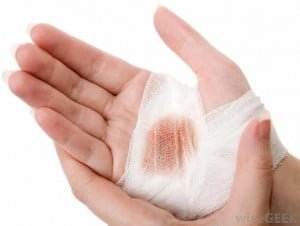 Our skin is an amazing organ. The skin is the part of our bodies that has direct interaction with the outside world. Our skin is what initially protects us from outside invaders or germs. In a nutshell, skin consists of two layers, the epidermis and the dermis. The epidermis is the outermost layer, the part that you can see if you look at your hands right now. The Dermis is the deeper layer of skin that is responsible for supporting the epidermis.
Our skin is an amazing organ. The skin is the part of our bodies that has direct interaction with the outside world. Our skin is what initially protects us from outside invaders or germs. In a nutshell, skin consists of two layers, the epidermis and the dermis. The epidermis is the outermost layer, the part that you can see if you look at your hands right now. The Dermis is the deeper layer of skin that is responsible for supporting the epidermis.
A wound is when the skin becomes broken or damaged because of an injury. There are many different types of wounds. Superficial wounds cause damage to the epidermis layer of skin, but not the dermis. Deep abrasions are cuts that go completely through the skin into underlying tissue. Puncture wounds are caused by sharp objects that cut completely through the skin into underlying tissue. Pressure ulcers are wounds that are caused by a lack of blood supply to the skin from constant pressure on an isolated area of skin.
As a home health care provider, we care for a lot of patients that need wound care. Wound care is nursing care that is provided to help treat and heal chronic or acute wounds. For the most part, wounds that are treated in home health care are chronic wounds. Most chronic wounds are associated with poor blood circulation to areas of the skin. Some chronic wounds include wounds that can reopen like surgical wounds, pressure ulcers, injuries to the feet or legs of people that have poor circulation, or diabetic ulcers.
There are multiple factors that affect how a wound heals. Providing wound care in the home differs from providing the service in an in-patient setting. The process starts by a home health care nurse coming to your home to do a thorough complete assessment, which includes a wound care assessment. The assessment is shared with your Physician, and a Skilled Nursing Plan of Care is developed. There are many factors that are taken into consideration by the home health agency and your Physician as to what the plan is to heal the wound. In all cases, this requires the nurse to come to your home on a regular schedule to assess the wound, clean the wound, treat the wound, and dress the wound. A record is kept and shared with your Physician that documents the healing progress of the wound. If your Physician feels a change should be made to the wound care plan, he or she will give the home health agency a written MD order to change the wound care. Once the wound is healed, you will have one final nursing visit called the discharge visit. During this visit, future instructions will be discussed with you, and you will be given a discharge summary that explains what preventative care should be taken going forward.
With home health wound care, there are some things that any client can do to help facilitate the healing of their wound. The most important thing is to be compliant with the care you are receiving from the home health agency. We only have your best interests in mind, and the plan of care we have developed will not work if you do not follow the plan. Other things you can do are washing your hands regularly and keep the dressing on your wound clean. Be careful not to reinjure your wound by bumping into things or touching your wound. Lastly, you need to eat right. Make sure you eat a well-rounded diet that is high in protein and nutrients. If you are a diabetic, make sure you eat a diabetic appropriate diet.
If a person is on Medicare and requires wound care, home health care agencies can only provide care if that person is homebound. For more information about how Medicare pays for home health care, please visit our What is Home Care page, on this page look under Who Pays For Home Care then Medicare.
Recent Comments